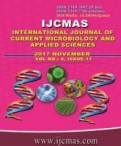


 National Academy of Agricultural Sciences (NAAS)
National Academy of Agricultural Sciences (NAAS)

|
PRINT ISSN : 2319-7692
Online ISSN : 2319-7706 Issues : 12 per year Publisher : Excellent Publishers Email : editorijcmas@gmail.com / submit@ijcmas.com Editor-in-chief: Dr.M.Prakash Index Copernicus ICV 2018: 95.39 NAAS RATING 2020: 5.38 |
Biogas is generated from the anaerobic-digestion of organic-wastes and is a rapidly emerging means for power generation. The seed-cake after oil extraction can serve as a good feedstock for the generation of biogas. This study presents summary of the results obtained in the anaerobic digestion of neem and pongamia deoiled-cakes with different proportions of cow-dung. The study revealed that the pH of cow-dung slurry at the beginning was 7.8; neem-cake, 5.0 and pongamia-cake, 5.8 suggesting significant differences in pH among the bio-gas substrates used. Two months after anaerobic-digestion, there was increase in pH with increase in the proportion of cow-dung and also increase in total-N and P in biogas spent slurry after anaerobic-digestion. There was no definite trend with reference to total-K. There was a decrease in total soluble solids (organic-matter), volatile solids, C/N-ratio and volatile fatty acids at the end of digestion. Significantly, very low C/N-ratio was recorded in treatments 4:1 cow-dung: neem-cake and 1:1 cow-dung: pongamia-cake (3.24) at the end of 60 days. The cumulative biogas for nine weeks was significant with cow-dung (15,755 cc) followed by 4:1 cow-dung: neem-cake. This suggests that oil-cakes can serve as good feed stocks for biogas production.
 |
 |
 |
 |
 |